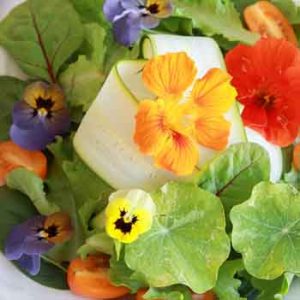
More evidence that low-calorie sweeteners are bad for your health
Studies show that artificial sweeteners can raise the risk of hypertension, metabolic syndrome, type 2 diabetes and heart disease, including stroke.

Natural Health News — Edible flowers provide new colours, textures and vibrancy to any dish, and apart from the “glam” factor, they can constitute new sources of bioactive compounds, according to Portuguese researchers.
In ancient Rome, various species of rose flowers (Rosa spp.) were used to prepare purée and omelettes.
In Medieval France, the flowers of calendula (Calendula officinalis L.) were used to prepare omelettes but also salads or as an accompaniment cheese. In Mexico, Dahlia flowers are commonly consumed in different type of dishes, for example in dried soups.
Today, according to researchers from the Polytechnic Institute of Bragança in Portugal edible flowers represent “an unexplored niche market with great economic and social importance being used since ancient times in culinary preparations, such as sauces, liquors, salads and desserts, and also in the preparation of hot beverages (tisane and infusion), mainly in European countries, due to their medicinal properties.”
» Flowers have a long use in cooking, adding colour and flavour to a variety of dishes.
» A new study by Portuguese researchers suggest they may also be rich sources of extra nutrients.
» In this study, calendula flowers were the richest source of carbohydrates, protein ash and healthy fats, followed by rose and dahlia flowers.
Edible petals
The researchers selected edible petals and infusions of dahlia, rose, centaurea (knapweed) and calendula – commonly known as marigolds and already used by the nutrition industry as a source of carotenoids.
They analysed the macronutrient composition, energetic value, fatty acids, soluble sugars, organic acids and tocopherols of the petals, which was then compared to the nutritional composition of their infusions.
Carbohydrates were the most abundant macronutrients, followed by proteins and ash. Fructose, glucose and sucrose were identified in all the petals and infusions
More specifically the results published in the journal Food Chemistry showed that calendula petals provided the highest content in total fat, ash and energetic contribution, as well as polyunsaturated fatty acids mainly as linolenic acid and total tocopherols mainly as alpha-tocopherol.
The highest values of total proteins, soluble sugars and organic acids were found in rose petals.
Meanwhile centaurea provided the highest carbohydrate content and the lowest percentage of saturated fatty acids.
Time for tea
The researchers then made infusions from all the flowers and analyzed these. Dahlia and rose showed the highest content in carbohydrates and rose the highest energetic contribution.
Calendula infusion showed the highest content in sugars, while the highest content in organic acids was found in the centaurea infusion.
“These results demonstrate that edible petals can be consumed in a daily diet as a nutrient source, and could also be used to prepare infusions to be consumed worldwide,” the researchers said.
Other researchers agree
Previous research agrees. Spanish researchers note that edible flowers including roses, violets and nasturtium can provide “biologically active substances” including vitamin A, C, riboflavin, niacin, minerals such as calcium, phosphorous, iron and potassium.
Other European research has shown elderflowers, mallow and French honeysuckle contain valuable antioxidants including rutin, quercetin, luteolin, kaempferol, and myricetin.
Results from these and other studies suggest that some of the distinctions we make between food and not food may be arbitrary and may mean we are missing out on some extra nutritional benefits.

Please subscribe me to your newsletter mailing list. I have read the
privacy statement